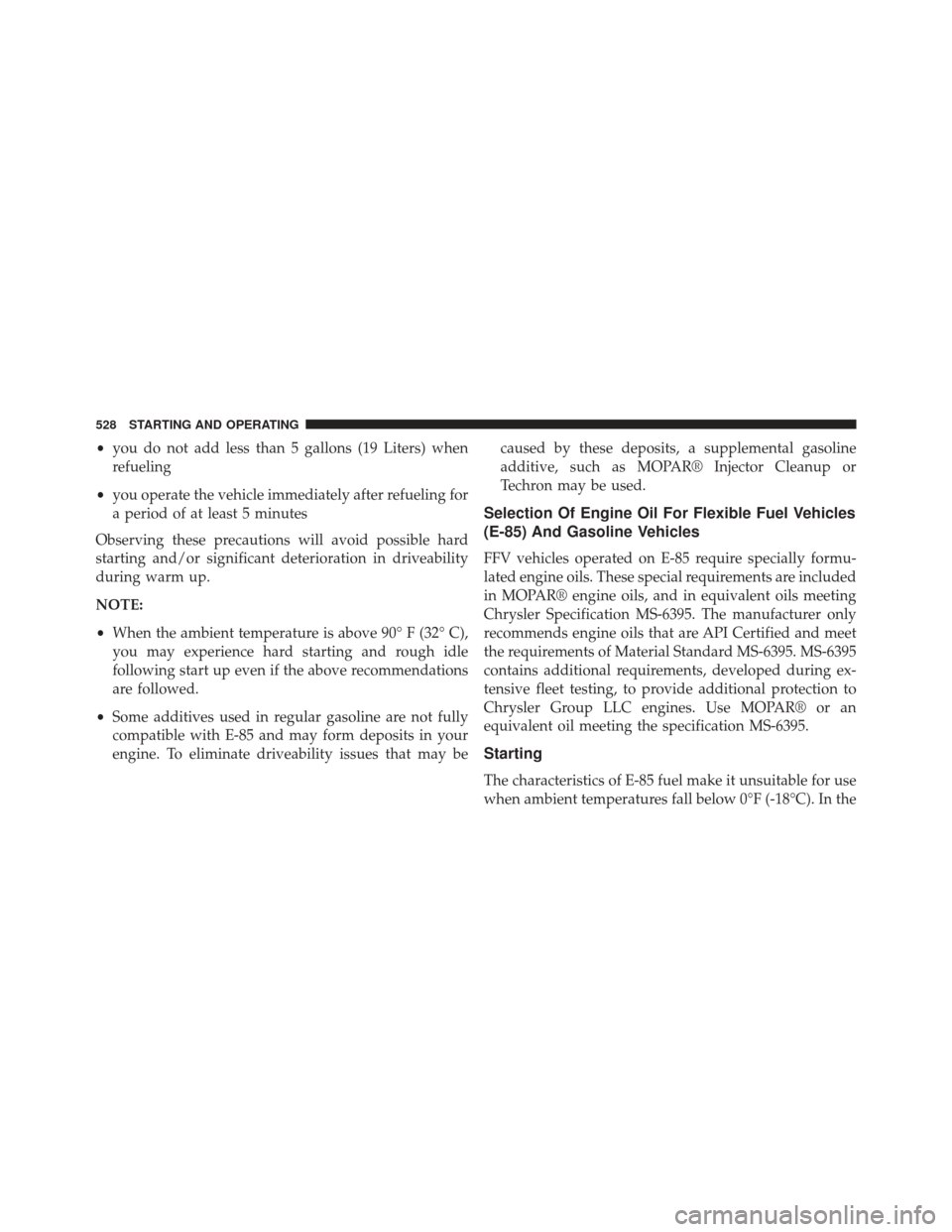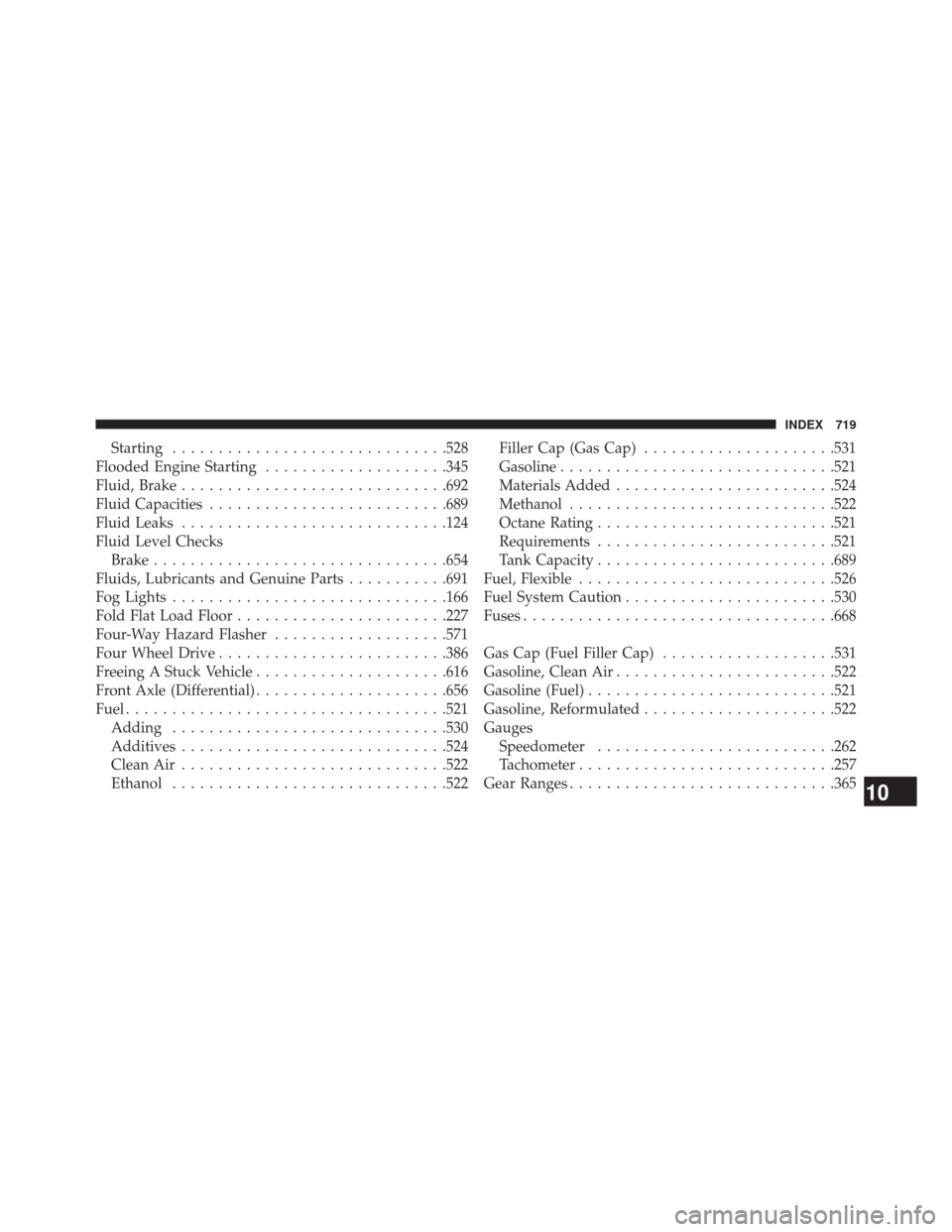fuel additives Ram 1500 2013 Owner's Manual
[x] Cancel search | Manufacturer: RAM, Model Year: 2013, Model line: 1500, Model: Ram 1500 2013Pages: 734, PDF Size: 5.47 MB
Page 526 of 734

blended with MMT provides no performance advantage
beyond gasoline of the same octane number without
MMT. Gasoline blended with MMT reduces spark plug
life and reduces emissions system performance in some
vehicles. The manufacturer recommends that gasoline
without MMT be used in your vehicle. The MMT content
of gasoline may not be indicated on the gasoline pump,
therefore, you should ask your gasoline retailer whether
the gasoline contains MMT. MMT is prohibited in Federal
and California reformulated gasoline.
Materials Added To Fuel
All gasoline sold in the United States is required to
contain effective detergent additives. Use of additional
detergents or other additives is not needed under normal
conditions and they would result in additional cost.
Therefore, you should not have to add anything to the
fuel.
Fuel System Cautions
CAUTION!
Follow these guidelines to maintain your vehicle’s
performance:
•The use of leaded gas is prohibited by Federal law.
Using leaded gasoline can impair engine perfor-
mance and damage the emissions control system.
• An out-of-tune engine or certain fuel or ignition
malfunctions can cause the catalytic converter to
overheat. If you notice a pungent burning odor or
some light smoke, your engine may be out of tune
or malfunctioning and may require immediate ser-
vice. Contact your authorized dealer for service
assistance.
(Continued)
524 STARTING AND OPERATING
Page 527 of 734

CAUTION!(Continued)
•The use of fuel additives, which are now being
sold as octane enhancers, is not recommended.
Most of these products contain high concentrations
of methanol. Fuel system damage or vehicle perfor-
mance problems resulting from the use of such
fuels or additives is not the responsibility of the
manufacturer.
NOTE: Intentional tampering with the emissions control
system can result in civil penalties being assessed against
you.
Carbon Monoxide Warnings
WARNING!
Carbon monoxide (CO) in exhaust gases is deadly.
Follow the precautions below to prevent carbon
monoxide poisoning:
(Continued)
WARNING! (Continued)
•Do not inhale exhaust gases. They contain carbon
monoxide, a colorless and odorless gas, which can
kill. Never run the engine in a closed area, such as
a garage, and never sit in a parked vehicle with the
engine running for an extended period. If the
vehicle is stopped in an open area with the engine
running for more than a short period, adjust the
ventilation system to force fresh, outside air into
the vehicle.
• Guard against carbon monoxide with proper main-
tenance. Have the exhaust system inspected every
time the vehicle is raised. Have any abnormal
conditions repaired promptly. Until repaired, drive
with all side windows fully open.
5
STARTING AND OPERATING 525
Page 530 of 734

•you do not add less than 5 gallons (19 Liters) when
refueling
• you operate the vehicle immediately after refueling for
a period of at least 5 minutes
Observing these precautions will avoid possible hard
starting and/or significant deterioration in driveability
during warm up.
NOTE:
• When the ambient temperature is above 90° F (32° C),
you may experience hard starting and rough idle
following start up even if the above recommendations
are followed.
• Some additives used in regular gasoline are not fully
compatible with E-85 and may form deposits in your
engine. To eliminate driveability issues that may be caused by these deposits, a supplemental gasoline
additive, such as MOPAR® Injector Cleanup or
Techron may be used.
Selection Of Engine Oil For Flexible Fuel Vehicles
(E-85) And Gasoline Vehicles
FFV vehicles operated on E-85 require specially formu-
lated engine oils. These special requirements are included
in MOPAR® engine oils, and in equivalent oils meeting
Chrysler Specification MS-6395. The manufacturer only
recommends engine oils that are API Certified and meet
the requirements of Material Standard MS-6395. MS-6395
contains additional requirements, developed during ex-
tensive fleet testing, to provide additional protection to
Chrysler Group LLC engines. Use MOPAR® or an
equivalent oil meeting the specification MS-6395.
Starting
The characteristics of E-85 fuel make it unsuitable for use
when ambient temperatures fall below 0°F (-18°C). In the
528 STARTING AND OPERATING
Page 716 of 734

Adding Engine Coolant (Antifreeze)............649
Adding Fuel ............................ .530
Additives, Fuel .......................... .524
Adjustable Pedals ........................ .179
Airbag ..................................66
Airbag Deployment ........................80
Airbag Light .............................74
Airbag Maintenance ........................82
Airbag, Side ..............................69
Airbag, Window (Side Curtain) ................70
Air Cleaner, Engine (Engine Air Cleaner Filter) . . . .640
Air Conditioner Maintenance .................642
Air Conditioning ......................... .315
Air Conditioning Controls ...................315
Air Conditioning Refrigerant .................642
Air Conditioning System ....................315
Air Pressure, Tires ........................ .494
Air Suspension .......................... .410
Alarm Light ............................ .262Alarm, Panic
.............................28
Alarm (Security Alarm) ......................21
Alarm System (Security Alarm) ................21
Alterations/Modifications, Vehicle ...............7
Antifreeze (Engine Coolant) ..................648
Disposal ............................. .651
Anti-Lock Brake System (ABS) ................470
Anti-Lock Warning Light ....................257
Anti-Theft Security Alarm (Theft Alarm) ..........21
Anti-Theft System ..........................21
Appearance Care ........................ .661
Ashtray ............................... .212
Auto Down Power Windows ..................45
Automatic Door Locks ......................37
Automatic Headlights ..................... .162
Automatic Temperature Control (ATC) ..........325
Automatic Transmission ....................355
Adding Fluid ......................... .660
Fluid and Filter Changes ..................661
714 INDEX
Page 721 of 734

Starting............................. .528
Flooded Engine Starting ....................345
Fluid, Brake ............................ .692
Fluid Capacities ......................... .689
Fluid Leaks ............................ .124
Fluid Level Checks Brake ............................... .654
Fluids, Lubricants and Genuine Parts ...........691
Fog Lights ............................. .166
Fold Flat Load Floor ...................... .227
Four-Way Hazard Flasher ...................571
Four Wheel Drive ........................ .386
Freeing A Stuck Vehicle .....................616
Front Axle (Differential) .....................656
Fuel .................................. .521
Adding ............................. .530
Additives ............................ .524
Clean Air ............................ .522
Ethanol ............................. .522Filler Cap (Gas Cap)
.....................531
Gasoline ............................. .521
Materials Added ....................... .524
Methanol ............................ .522
Octane Rating ......................... .521
Requirements ......................... .521
Tank Capacity ......................... .689
Fuel, Flexible ........................... .526
Fuel System Caution ...................... .530
Fuses ................................. .668
Gas Cap (Fuel Filler Cap) ...................531
Gasoline, Clean Air ....................... .522
Gasoline (Fuel) .......................... .521
Gasoline, Reformulated .....................522
Gauges Speedometer ......................... .262
Tachometer ........................... .257
Gear
Ranges ............................ .365
10
INDEX 719